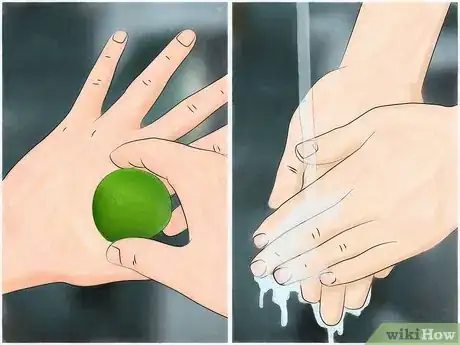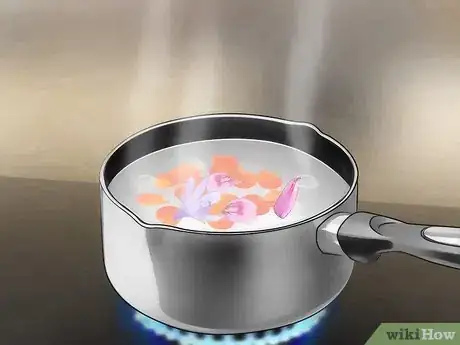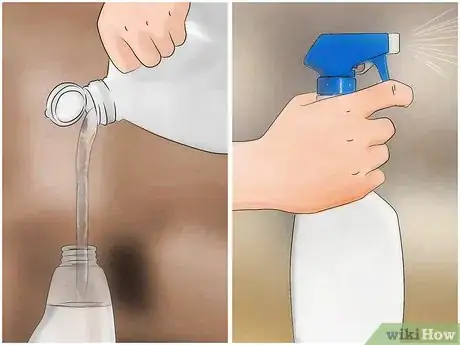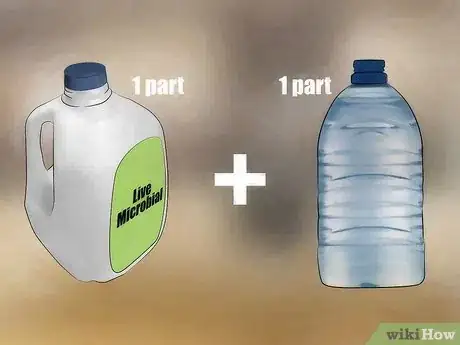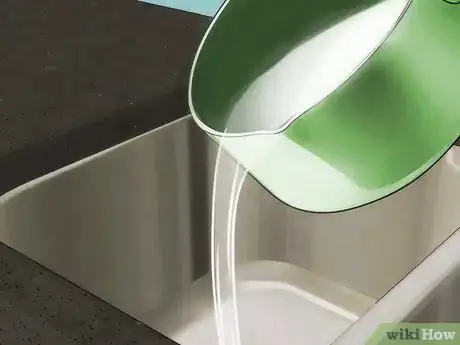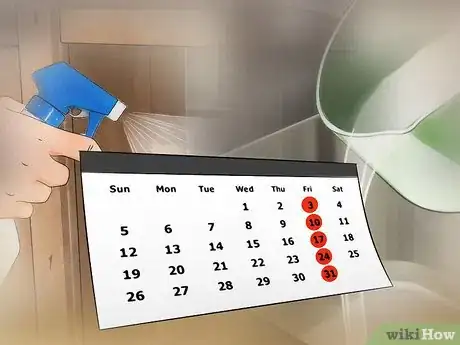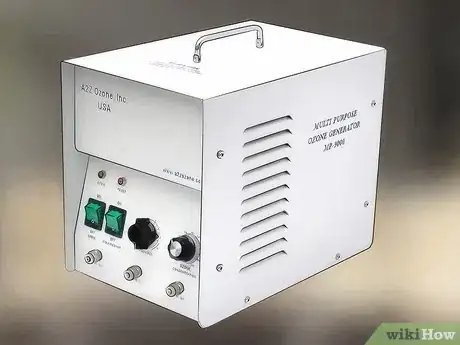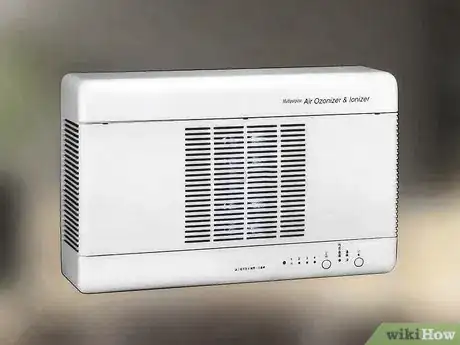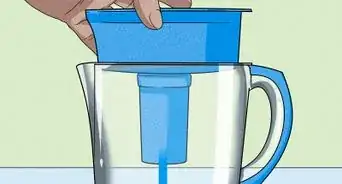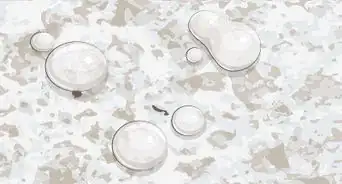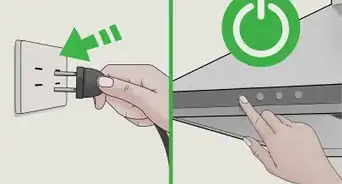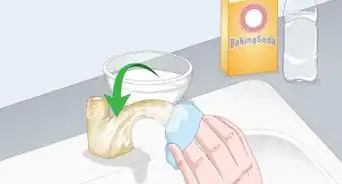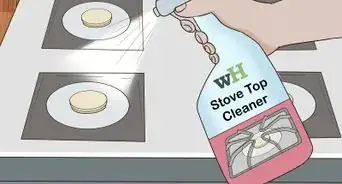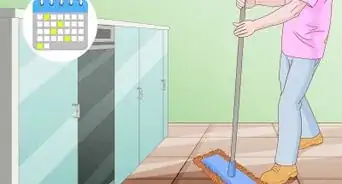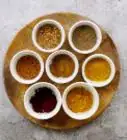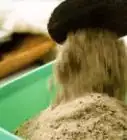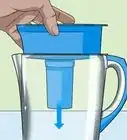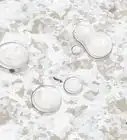This article was co-authored by Michelle Driscoll, MPH. Michelle Driscoll is the Owner of Mulberry Maids, which is based in Fort Collins, Colorado. With five years of experience, her business specializes in cleaning homes and small offices. She holds a Masters in Public Health from the Colorado School of Public Health. Additionally, Mulberry Maids has an A+ rating from the Better Business Bureau.
There are 15 references cited in this article, which can be found at the bottom of the page.
This article has been viewed 296,056 times.
Curry is a flavorful Indian-style dish that is made with many strong spices, such as turmeric and cumin. The strong odor can be extremely difficult to remove from an apartment or a residence because the spices release odorous vapors as they are cooked. Even after cooking, the vapors continue to penetrate permeable surfaces such as walls, carpets, upholstery and drapery. To successfully rid yourself of the problem, you must destroy the grease molecule. Through a combination of different cleaning methods, you can eliminate a curry odor from your home.
Steps
Covering a Curry Smell
-
1Wash your face and hands with lemon or lime. While in the shower, rub a piece of lemon or lime over the skin that most likely has deposits of vapors from cooking such as hands, face, and arms. The acidity in lime will help to break down the essential oils that cause the lingering curry smell. Finish by washing with soap and water as usual.
- Be sure to avoid open cuts or wounds on the skin as this can cause painful stinging or burning.
- Avoid putting on any of the same clothing articles that were used while cooking, for instance a hat or sweater.
-
2Use air freshening products. You can try using air diffusers, air deodorizing sprays, plug-ins, or scented candles. Also of great use are air fresheners that allow you to spray on fabrics. Spray all items that are in the cooking vicinity until damp, such as the carpet, upholstery, drapes or walls.
- A combination of many products will work well.
- Be sure to carefully read instructions on the packaging label to ensure proper use.
Advertisement -
3Boil flowers or leaves that emit a pleasant fragrance. Put two cups of water in a pot on the stove and bring it to a boil. Add fragrant materials such as Kewra (Screwpine) leaves or vanilla beans/extract, and turn the heat down to a simmer. Allow it to simmer for at least one hour. The smell emitted will mask the lingering curry odor.
- Screwpine leaves are also known as pandan leaves and can be purchased at the local Asian grocer or specialty grocery store.[1]
- There are no set specifications on how much screwpine or vanilla you should add. Try a few sprigs to begin with and add as needed.
- You can also try boiling other fragrant ingredients you have to get rid of the smell, such as 3 cups (720 mL) of white vinegar, 1 cup (240 mL) of water, and 6 cinnamon sticks.[2]
-
4Allow fresh air into your home. Open the windows for a day or two to allow fresh air to permeate through the residence. You may also need to replace filters in your heating or cooling systems so they don’t circulate odorous air.
Utilizing Cleaning Sprays
-
1Mix vinegar and water to absorb odors. Combine one cup water and two tablespoons of white vinegar in a spray bottle. Vinegar is a natural home remedy that has been known to deodorize a room.[3]
- It’s not likely to be a long-term fix, but you can also put bowls of vinegar around your home to absorb odors.
-
2Combine one part water to one part live microbial agent in a spray bottle. You can purchase the microbial agent online or at your local hardware store. Microbial agents have live bacteria that eat odor-causing microorganisms and claim to remove harsh odors from your home.[4]
-
3Spray your entire residence with the formula of your choice. Whether using vinegar or a microbial solution, spray everything including walls, cabinets, the carpet, the ceiling, grease traps, and draperies. Pay especially close attention to areas of built-up grease where the odor tends to permeate.[5]
- Before spraying, test for color fastness, or make sure a fabric will retain its color. Spray a small amount of mixture on an inconspicuous area of fabric. Wait a few minutes and blot with a napkin. Note any changes to the fabric, or any color rubbing off onto the napkin.[6]
- Avoid spraying around electronics and electrical outlets.
- Check your filter’s instructions to see if they are washable. They may be able to be washed in the solution while others will need to be washed in soap and water. Still, others may need to be replaced and can be purchased at your local hardware store.
-
4Use the microbial solution to clean drains in your home. Drain vents can often clog, causing odors to continue to saturate your residence. The microbial agents will help to clear the plumbing and eliminate odors.
- Follow instructions on the bottle’s label regarding how much to pour and how often.
-
5Repeat this process once a week. If the smell doesn’t go away immediately spray your solution and air out your home once a week. This allows the microbes to remain alive and to continue to break down the odor-trapping grease.
- If the smell still remains after 4 cycles, try combining with other odor-removal methods.
Removing Long-Standing Odors
-
1Sprinkle baking soda on your carpet and let it sit overnight. Baking soda absorbs odors, so sprinkle some over your carpet. Use just enough to create a light dusting. Then, leave the baking soda in place overnight. Vacuum it up the following morning.
- Make sure to keep pets and small children off of the carpets while the baking soda sits.
-
2Try steam cleaning your carpet and upholstery. There are professional carpet cleaners who will come to your home and steam clean carpet and upholstery, or you can purchase or rent steam cleaning machines to do the job yourself. Stores offer cleaning solutions that are specifically formulated for odor removal, or you can try other solutions such as Oxyclean, vinegar or bleach.[7]
- Do not steam clean for at least a month if you are using a microbial solution. Use the solution for 4 cycles before steam cleaning.
- Avoid using regular vacuums and cleaners such as baking soda or carpet shampoos because it doesn’t clean down to the carpet pads where odors could be trapped.
- Professional carpet cleaning costs vary greatly because it depends on the size of the home and how many rooms you will be cleaning. Overall, you can expect to pay an average of $51 per room. Some companies may also charge by the square foot.[8]
- Steam cleaner rentals usually have an hourly minimum for rental, but also allow you to rent per day. You can find the cleaner and products at your local hardware store.[9]
-
3Opt for an ozone generator to destroy molecules. Ozone (O3) is a reactive particle which chemically attracts and reacts with molecules in the air and on surfaces. The oxygen in ozone chemically changes the structure of the molecule to eliminate the odor. You can purchase ozone generators online or at your local hardware store for anywhere from a couple hundred dollars to a couple thousand dollars.
- Instructions usually suggest to let the generator run for an hour in a closed room, but you can allow it to run for 3-4 hours.[10]
- Ozone is effective in removing odors because as a gas, it is able to penetrate anywhere that air can go: walls, ceilings, vents, carpets, upholstery fibers and more.
- You can read online consumer reviews that discuss various features of ozone generators such as cost, size, noise, durability, and effectiveness.[11]
- Ozone generators are typically purchased for places where ozone is needed, such as places where there is gaseous pollution (like the smell of curry). They should not be used to remove allergens, as they have been known to cause greater health issues.[12]
-
4Opt for a photocatalytic air purifying process. Contact a company that has machines that use an Advanced Photocatalytic Oxidation (APO) process. This process utilizes air and water to create vaporized hydrogen peroxide, and reactive hydroxyl particles. This process cleans both air and surfaces in a home. Not only does it clean, but it breaks down compounds which hold odors.
- Most homes can be completed in 12 hours or less and clients, furniture, clothing, and rugs can remain in the home.
- You can also purchase photocatalytic air purifiers that use the same technology to zap odor-causing particles.[13] Purifiers and filters can be found online for about $200.
-
5Repaint your walls. Use turpentine to break down grease from kitchen surfaces. Then, strip the current paint off your walls by grinding, applying heat, or using chemicals. Next, apply an odor blocking and sealing primer which will both keep current odors from seeping out, and keep new odors from penetrating the paint. Lastly, choose your paint and mix in additives that have been known to block odors such as vanilla or chemical additives.
- To remove grease, mix equal parts turpentine, linseed oil, and white vinegar, and use a light cloth to wipe the grease off kitchen surfaces. There is no need to rinse when done. Simply allow to dry and buff with a cloth.[14]
- Turpentine can often have a noxious smell so be sure to use in a well-ventilated area, and use rubber gloves and a mask to protect yourself, and line your work area with cloth or cardboard.
- When mixing additives to your paint, add two tablespoons of vanilla extract to every gallon of paint. Or, you can mix in odorless additives (found at your local hardware or paint store) that actually remove odors, as opposed to just blocking them.[15]
Community Q&A
-
QuestionI just moved into an apartment and the previous tenants have left the apartment with a very strong stench of curry. Any suggestions? I already repainted, used OdoBan, and Febreze.
 Benit55Community AnswerI have done a lot of research on this topic. I'm buying an air purifier, which is cheaper than the ozone generator. The apartment should have been painted with Killz prior to painting. If you have carpet, try sprinkling baking soda and leave it for about 15 minutes before vacuuming it up.
Benit55Community AnswerI have done a lot of research on this topic. I'm buying an air purifier, which is cheaper than the ozone generator. The apartment should have been painted with Killz prior to painting. If you have carpet, try sprinkling baking soda and leave it for about 15 minutes before vacuuming it up. -
QuestionSomeone in cooking class for curry on my hands. What should I do?
 ERROR409Community AnswerI'd suggest you wash your hands more often than you regularly do and over time it'll disappear. If that doesn't work however, you could use a harsher soap or scrub, maybe one that mechanics use for their hands.
ERROR409Community AnswerI'd suggest you wash your hands more often than you regularly do and over time it'll disappear. If that doesn't work however, you could use a harsher soap or scrub, maybe one that mechanics use for their hands. -
QuestionWhat is a microbial agent?
 ERROR409Community AnswerAn antimicrobial agent is something that is used to counteract the growth of microorganisms or kill them. If that's the case for antimicrobial agents, then one can assume that a microbial agent is something that does the opposite and promotes microorganisms growth.
ERROR409Community AnswerAn antimicrobial agent is something that is used to counteract the growth of microorganisms or kill them. If that's the case for antimicrobial agents, then one can assume that a microbial agent is something that does the opposite and promotes microorganisms growth.
Warnings
- When using chemicals, be sure to utilize in a well-ventilated area, and use gloves and a mask to protect yourself.⧼thumbs_response⧽
References
- ↑ http://theepicentre.com/spice/pandan-leaf/
- ↑ https://www.hunker.com/13421029/how-to-get-rid-of-curry-odor
- ↑ https://lifehacker.com/remove-odors-from-your-entire-home-by-simmering-vinegar-1734127248
- ↑ http://www.thriftyfun.com/tf517193.tip.html
- ↑ http://www.thriftyfun.com/tf517193.tip.html
- ↑ http://www.stain-removal-101.com/colorfastness.html
- ↑ http://www.thefrugallife.com/sourhouse.html
- ↑ https://www.angieslist.com/articles/what-are-average-carpet-cleaning-prices.htm
- ↑ http://www6.homedepot.com/tool-truck-rental/Carpet_Cleaner/95371/
- ↑ http://www.trulia.com/voices/Agent2Agent/How_to_remove_strong_smells_from_a_house_-641652
- ↑ http://www.consumerreports.org/cro/air-purifiers/buying-guide.htm
- ↑ http://www.negativeiongenerators.com/ozone-good_or_bad.html
- ↑ http://www.explainthatstuff.com/how-photocatalytic-air-purifiers-work.html
- ↑ http://www.howtocleanstuff.net/how-to-clean-kitchen-cabinets/
- ↑ https://www.amazon.com/ZORBX-Odor-Remover-Paint-Additive/dp/B003N8PK3S
- ↑ https://www.hunker.com/13421317/how-to-get-indian-curry-smell-out-of-the-house
About This Article
To remove a lingering curry odor, try making a cleaning spray with white vinegar. First, combine 1 cup of water and 2 tablespoons of white vinegar in a spray bottle. Spray everything in the room, including the walls, cabinets, carpet, ceiling, grease traps, the hood of the stove, and drapes. Pay extra attention and spray more in areas where grease has built up and where the smell seems to be coming from. If the smell doesn’t go away immediately, spray the solution all over the room once a week to allow the microbes to break down the odor-trapping grease. For tips about how to remove long-standing curry odors with baking soda, keep reading!
